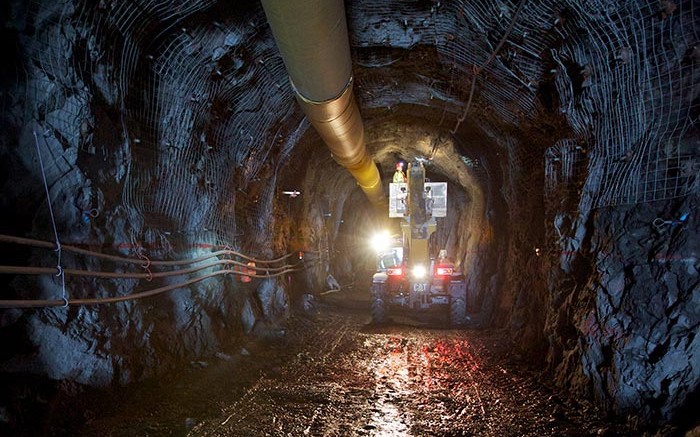As we look in the waning days of summer to the United States’ Southwest in this edition, it strikes us that there’s been a staggering number of days that only saw three mines start production in Canada’s southern neighbour.
It’s something like 6,600 days – or 18 years – according to a recent study by S&P Global. The most recent major approval for a new mine now in production is Lundin Mining’s nickel-copper Eagle mine in northern Michigan, which began commercial output in 2013, more than a decade ago.
Northern Star Resources’ Pogo gold mine in Alaska started in 2006 (under a previous operator) and the Ruby Hill gold mine in Nevada started mining a new deposit in 2007 (it’s now a past-producer).
Benefiting from a push for domestic production of critical minerals construction at Lithium Americas’ Thacker Pass in Nevada is under way, after that project gained approval in 2021 — and a promise of US$2.2 bil- lion in federal funding this year.
Still, the U.S. has the second-longest lead time in the world for developing a new mine from discovery to production: 29 years. Canada isn’t much better than the U.S. at around 27 years. The crown for the dubious honour at 34 years goes to Zambia in Africa’s copper belt, which only recently has been able to unburden itself from US$13 billion in debt thanks to partial refinancing led by China.
The Asian giant also figures in pointing out the lack of mine approvals in the West. In mid-August, Beijing imposed export restrictions on antimony, a critical mineral used in semi-conductors and lots of weapons. These followed limits imposed last year on gallium and germanium, also used in computer chips, as China wields resource nationalism as a form of blackmail.
Antimony – no small potatoes
China produces nearly half of the world’s antimony, a quarter comes from Tajikistan, while Russia and Myanmar source smaller amounts. The U.S. doesn’t produce any.
Now Washington is showering record cash on one antimony project in Idaho, which could be developed into one of the world’s largest.
Perpetua Resources’ proposed revamp of the former Stibnite gold and antimony mine is earmarked for US$1.8 billion in debt financing from the Export-Import Bank and US$60 million from the Pentagon. But the project has been caught in the approvals process since 2016 as the company navigates local, state and federal regulations.
An OK from the U.S. Forest Service could arrive this year, but potential legal challenges – like for most mining applications, including Lithium Americas’ project – loom from conservationists and Indigenous groups.
Idaho has prioritized expedited permitting for projects that involve critical minerals for national security and the green economy. The Idaho Department of Lands says it’s making permitting faster, like other Western and Southwestern states such as Nevada, Texas, New Mexico, Arizona and Utah.
Texas Mineral Resources is preparing a prefeasibility study for the Round Top rare earths project near El Paso. The deposit has 16 of 17 rare earths like the ones used in electric vehicle motor magnets and is estimated to be worth US$1.6 billion. Rare earths mining can be dirtier than other types and local environmentalists fear it will contaminate the groundwater.
Defence dollars
It’s a dilemma for the Biden administration that might continue under a president-elect Kamala Harris to fund projects for an electric future while trying to stem the pollution to get there. When the world’s largest military depends on the minerals for some 300 of its munitions and politicians want independence from a China flexing more swagger, it would seem the choice is clear that more mines need to be built on this continent. The Pentagon in August even reached across the border to invest US$20 million in Electra Battery Materials’ proposed Ontario cobalt refinery, adding to $10 million from Canada.
Rio Tinto, which is developing the Resolution copper mine in Arizona with minority partner BHP, could end up in the U.S. Supreme Court if an Indigenous group opposing the project has its way. The Apache Stronghold is fighting the project, which could potentially supply a quarter of the country’s needs for the wiring and plumbing metal, on the basis of religious freedom. It contends the land was used for Indigenous ceremonies for centuries.
Its lawyers say the Supreme Court has heard 25 religious freedom cases since 2011 and sided with those arguments 24 times. However, it remains to be seen if the conservative-leaning bench will take on the case. A federal court of appeals has already declined it.
If the mine were ready to start producing now, it would meet that 29-year average of time from discovery to output researched by S&P.
Duplication cuts
We’ve already noted Canada isn’t much better at approval times. Still, Natural Resources Canada has vowed to work with provinces to eliminate duplication in regulatory approvals.
Another attribute could be Canada’s perhaps over-hyped reputation for friendliness, to a point, at least. S&P says that even with lengthy approval times, mines are much more likely actually to be built in Canada than face a gauntlet of lawyers like in the U.S.
Even if mines south of the border receive all their permits, they face higher litigation risk, S&P says. It found more mentions of lawsuits against U.S projects than of ones opposing Canadian and Australian properties combined. It could explain why investors backed 81% more exploration budgets in Canada vs the U.S. over the last 15 years, the researchers said.
Mining, with fewer strings attached, could be Canada’s calling card as the U.S. can offer cash to developers, but not the certainty they seek.


Be the first to comment on "Editorial: Mining-powered rockets vs dockets "